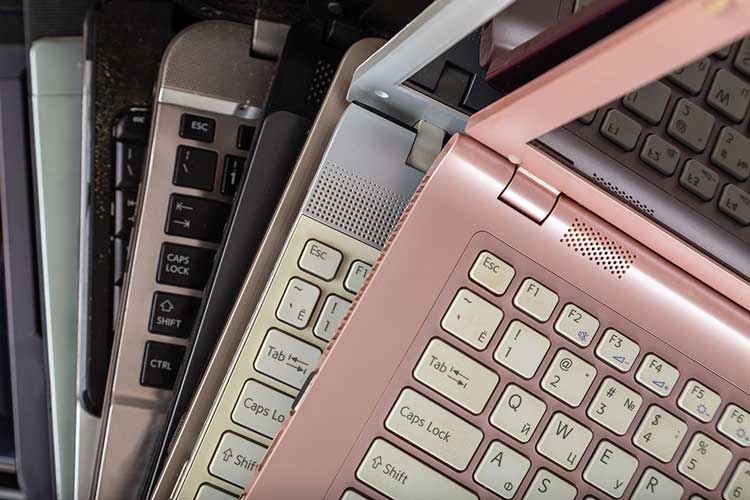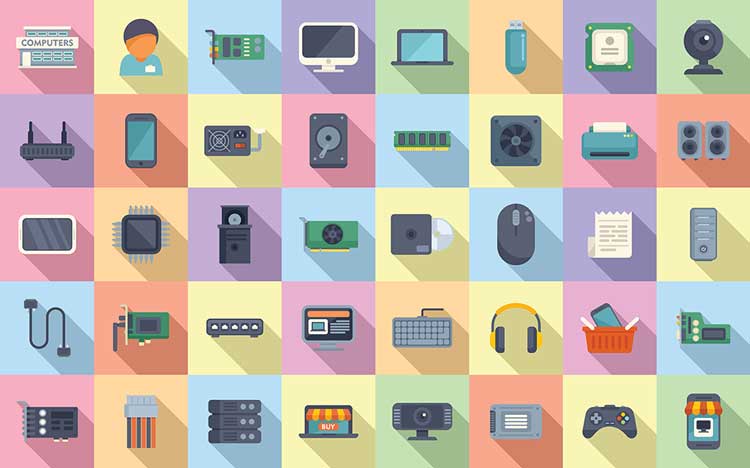How to Choose a Computer or Device
Last updated May 2025

To have something to sell to a wide range of buyers, most manufacturers offer a dizzying array of options: laptops, desktops, tablets, Chromebooks, and 2-in-1 tablet/laptop combos. Within each type of device, manufacturers offer several models with a wide range of capabilities and price points.
Here’s how to find the right gadget. Start by deciding what you want and need—and ruling out what you don’t.
Do Some Homework
Fortunately, there are numerous reliable sources of product reviews. Websites such as PCMag and Wirecutter provide excellent computer and software buying advice plus product overviews by editors. Consumer Reports also evaluates computers, monitors, printers, routers, and some software. And big sellers such as Amazon and Best Buy provide hundreds of reviews from consumers who have already purchased products.
Salespeople at local stores also may provide sound advice. Our ratings of computer retailers will help you find businesses with helpful staff—and steer you away from lousy stores.
There are dozens of decisions to make—desktop vs. laptop vs. tablet vs. hybrid designs; Apple vs. PC; size, weight, and battery life; speed; video performance; storage and memory capacities; expandability; and more. Here’s some advice:
Apple vs. PC vs. Chromebook
The differences between devices from Apple and other manufacturers (whose computers are known as “PCs”) are less distinct now than in the past. Mostly, it comes down to the interfaces they use.
A third type of laptop runs on Chrome, an operating system created by Google. Like PCs, several manufacturers make Chromebooks.
These devices are usually inexpensive (starting at less than $200), but there are also models with capabilities comparable to higher-end PCs. Because the operating system for Chromebooks uses Google’s cloud-based software, you won’t need much internal storage space—but you will need a reliable internet connection. And know that some popular software applications won’t run on Chromebooks.
Thinking about defecting—say, from a PC to Apple? Your primary concern will be compatibility, because it may be inconvenient to move work back and forth between the two families of devices. There are also some benefits to pairing an Apple product to an iPhone, or a PC or Chromebook to an Android phone.
Also make sure you and your family can run the same programs at home that you do at your offices and schools. If you or a family member has extensive experience with either type of computer, it’s probably easier to stick with what you know.
Brand Reliability
While reliability is a major consideration when buying electronics, Consumer Reports’ surveys of buyers typically find minimal differences in post-purchase problems among the major manufacturers, with one notable exception: Apple, for decades, has outscored its competition in this area.
Don’t want an Apple product? Compare performance, features, and prices on models from several of the other major brands, since most have similar reliability records. And shop around: For PCs and Chromebooks, prices vary considerably among major brands for similarly configured computers.
Portability
Laptops, tablets, and 2-in-1 laptop/tablet mashups have become so capable, convenient, small, light, and inexpensive that they now dominate device sales. When shopping for one, consider its speed, storage, and other capabilities. Plus, if you plan to travel with your laptop, compare size, weight, and battery life.
Larger computers are more cumbersome, but smaller devices come with smaller screens and keyboards. A slightly larger, heavier model could make typing and screen viewing easier. On the other hand, while flying coach it’s nearly impossible to use a laptop with a screen larger than 16 inches.
Also compare battery life. Three to six hours is typical, but some affordable laptops now offer 12 hours or more. Check product reviews for realistic assessments; manufacturers tend to exaggerate how long their devices last between full charges.
Processors
A computer’s brain is its central processing unit (CPU), processor, or “chip.” For PCs and Chromebooks, the three major manufacturers are AMD, Intel, and Qualcomm. For Macs, Apple now uses its own “M” series processors; M4 is the latest.
Processors are critical to performance. Each new generation of manufacturers’ chips is built with improved structure and logic to process information faster than previous generations.
In ads you may see a computer that comes with an “Intel Core i9 24-core 5.8 GHz” processor. The 5.8 GHz (gigahertz) is the level of “clock speed” at which the processor operates. As this number increases, so does the processor’s speed. But because each new generation of chips uses more efficient logic, and has a more efficient design that produces faster overall speed, you can’t compare chips from different generations by looking only at their respective processing speeds. The latest chips run far faster than those made just a few years ago when running at the same GHz processing speed.
When comparing processing options, in addition to comparing generations and speeds, check how many “cores” you get. In a processor with eight cores, the manufacturer essentially has bundled together eight chips into one, which means the computer’s processor can churn through information roughly twice as fast as a computer using a processor that bundles together just four chips.
Don’t bother splurging on the latest greatest processor if you use your computer mainly for email. If you want to stream video, speed is important, but most new processors—even inexpensive options—will perform well. But even light users may have to keep their computers up to date to utilize many common programs—such as tax-preparation software—that are continually redesigned with graphics and other features to make them more user-friendly but require chips with higher processing speeds. Also, if you buy a computer that’s much slower than one that you use at work or school, you may get frustrated while you wait for it to complete tasks.

Display
For laptops and tablets, screen size and display quality impact price. When choosing a laptop, remember that one with a larger display will be more difficult to drag around. And many laptops now come with touchscreens, which cost more than conventional displays.
When considering display quality, if you plan to watch movies or TV shows you’ll want at minimum a full-high-definition model (1920 x 1080 resolution); fortunately, most entry-level models now come with that. Ultra-high definition (UHD) (3840 x 2160 or better) costs more.
Want a monitor larger than 24 inches or UHD? Compare prices of dedicated computer monitors and TVs, since you can connect either to your computer with an HDMI cable.
Storage Drives
Most day-to-day computer work entails moving information to and from your hard drive. The size of hard drives is measured in megabytes (MB), gigabytes (GB), and terabytes (TB), with 1,024MB equal to 1GB and 1,024GB equal to 1TB. Most new laptops come with hard drives ranging from 250GB to 1TB; tablets usually come with 32GB to 128GB of storage.
There are solid-state drives (SSDs) and conventional hard-disk drives (HDDs). Because they lack moving parts, SSDs offer faster speeds, use less power (which means longer battery life), and fail less often than HDDs. Very few new laptop models have HDDs anymore. If you care about speed and want anything other than a very basic model, buy a computer model that comes with an SSD.
If you’ll be using your computer primarily to mess around on the web, send and receive email, and do other basic tasks, you won’t need much storage-drive space; for a computer, even a small 250GB drive will have enough capacity. If you stick with a tablet and won’t use it to save photos, videos, or download movies or games, you’ll likely need only 32GB or 64GB.
You can also expand your storage space by buying an external drive or subscribing to a cloud-based storage service. Both of these options are also convenient for backing up your files (which you’re regularly doing, right?).
Random Access Memory
A computer uses random access memory (RAM) to hold some of the data needed to run its operating system and other software in use.
The more RAM your computer has, the more tasks it can perform simultaneously, which speeds operations. If it has only the minimum amount of RAM a program requires, only the most commonly used parts of the program may be in RAM all the time, and less commonly used parts will have to be fetched from the hard drive when needed. That fetching takes time that could be saved if more of the program is held in RAM.
As for processors, there are various generations and types of RAM, with the latest ones designed to operate faster than previous generations. A boiled-down explainer: DRAM (dynamic random access memory) uses more power but can store more stuff and costs less than SRAM (static random access memory) types.
RAM is measured in megabytes (MB) and gigabytes (GB), which indicate how much data the device can store in memory. Because buying additional RAM is usually inexpensive, and more is better, purchase as much RAM as your system and budget allow.
Graphics Processing Units
To display HD video and graphics-intensive games efficiently, computers shift the processing workloads of graphics from their central processors to graphics processing units (GPUs) designed specifically to process and display this information.
Like central processors, newer generations of GPUs are built and programmed to operate faster than previous ones. For example, new GPU chips can quickly process 3D graphics used in games and UHD video.
Because advancements in home computing largely have been—and will continue to be—in the graphics and video areas, take a more-is-better approach when selecting a GPU. Get a model with a graphics chip with 4GB or more of memory. To play the latest and greatest games, get at least 8GB.


